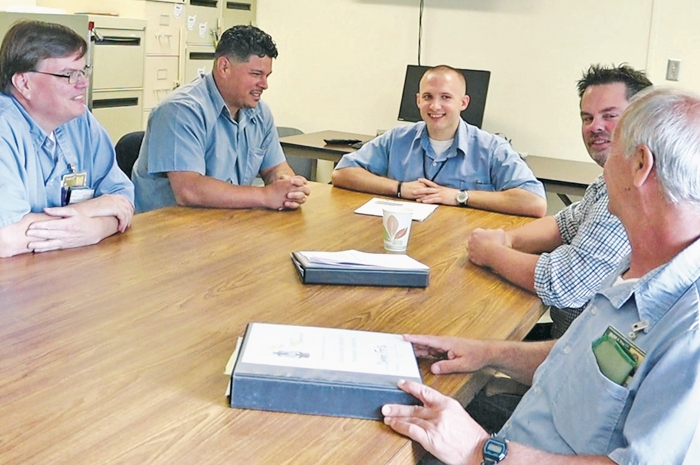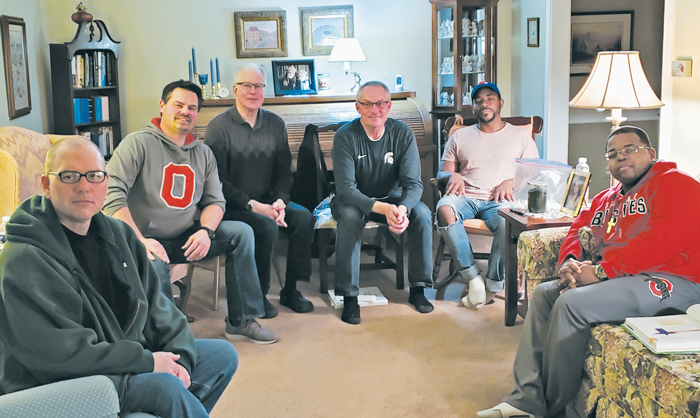As published in Development News - February 1, 2021

Tom Ostrosky (second from right) speaks with a group of prisoners
Lazarus Experience aids workforce development
Recidivism (The tendency of a convicted criminal to reoffend and return to prison) costs Ohio taxpayers over $207 million per year. Could there be a better way to keep former inmates out of the system and provide the region with a much needed workforce? Ask an ex-con…
After spending multiple years in prison, Tom Ostrosky realized he needed to go back; this time, however, as a mentor to those still doing hard time. But his new calling didn’t come immediately upon his release.
In 2007, Ostrosky, a bank employee, was convicted and sentenced to federal and State prison for embezzlement. In retrospect, he understands the pressures that led to his actions, but he makes no excuses. And though not embittered by his experience, he’ll be the first to admit that it was anything but easy.
“There was a lot of guilt, regret, depression, self loathing,” said Ostrosky, who saw the coldness of prison – the steel, the concrete walls, all as metaphors for a hardening heart and dying spirit that could have enveloped him had it not been for his upbringing. He was raised to know the difference between right and wrong and a still, small voice of conscience refused to die. Then a friend mailed him Rick Warren’s book, The Purpose Driven Life. What on Earth am I Here For?
“If I were asked, ‘What was the one thing that changed my life?’, the answer would be that book. I read it every year during Lent,” said Ostrosky.
Not knowing what his future held yet stepping out in faith, he completed his sentence and earned his release. But his “freedom” took a bit more time.
Life on the outside is not easy for any former offender and Ostrosky, who felt his life had no direction, experienced all of the same post-prison attitudes. He was able to land a job in three days but it seemed nobody really cared. He tried to re-assimilate at the church he previously attended by helping out with kids’ sports and other volunteer programs but soon learned that many parishioners didn’t want “his kind” around.
It was a Match.com date that brought him to a different church where the sermons sounded more “Christ-like.”
“Here was a message of inclusion, of love, of service – and of using one’s own experiences to find God’s purpose in your life,” said Ostrosky.
That was in October 2014. After spending considerable time in prayer and reflection he knew that his calling was to be of service to others exiting the system.
Offering himself as a mentor for men dealing with life after incarceration, he volunteered for a post-release program. In time he learned that, with all its good intentions, the program was reaching these men too late.
“They were using the group therapy times to gauge where they could traffic their drugs and pick up women. Staying out of the system was not a priority with many of them,” said Ostrosky.
That’s when he realized he had to reach these men way before their release date. And he needed to share his message of God’s grace to anyone truly yearning to be changed from the inside. He also knew that he needed an evidence-based therapeutic curriculum to guide his efforts.
After researching upwards of 30 cognitive behavior courses, Ostrosky purchased what he felt would best serve current inmates. At the same time, Pastor Michael O’Shea of Waterville Community Church, who had been Ostrosky’s spiritual counselor since he first attended the church, joined in the effort of designing a program by blending biblical teachings with sound, proven, psychological advice and exercises. In the end, they had created their own, unique curriculum targeted at changing one’s thought process and subsequently resulting in positive ideas and better decision-making.
Ostrosky now had a tool with which to minister to those men still entombed by their pasts. He was ready to try out his “Lazarus Experience.”
The name is based on John 11:44 – And the dead man came out, his hands and feet bound in grave-clothes, his face wrapped in a head-cloth. Jesus told them, “Unwrap him and let him go.”
The Mission statement expands upon the miracle of Lazarus…
… to transform the lives of incarcerated men … by going into prison to build relationships … that change thinking and behavior…all to enable successful transition into productive family and community life.
In 2017, Ostrosky launched a pilot program at Gus Harrison Correctional Facility in Michigan. Mainly he needed to know if there was any interest. Six men showed up for that first class. The next meeting hosted nine prisoners – three recruitments from the first group. And that’s how the program has grown; word of mouth from inside the prison.

Tom Ostrosky (second from left) at a meeting of the Lazarus Experience’s First Relationship Disciple Team
Allen Correctional Institute in Lima, Ohio, with a population of 25% Lucas County offenders, then opened its doors to Ostrosky and his volunteers, introducing more hungry men to The Lazarus Experience.
Phase 1 (pre-release) allows prisoners (regardless of offense) to share their stories and begin the journey of transformation. Here is where the foundation for accountability begins by outlining expectations and commitments. It is also the cornerstone of what will be an ongoing relationship with God through daily prayer.
Phase 2 is a six to nine month transition phase. As the participants move from prison life to community life, they are supported in implementing their personal 90-day reentry action plan and obtaining all basic needs, including but not limited to: housing, identification documents, employment, clothing, transportation, medical, cell phone service, etc.
“Landing a job is a requirement for our participants,” said Ostrosky, who has utilized, with much success, the resources of OhioMeansJobs. “But we encourage them to dream bigger. A career should not be out of reach to any of these guys.”
Their success stories reflect a special kind of employee; responsible, dedicated, and grateful…
Devante J. started working for a local landscaping company as an entry level maintenance crew member in March 2018. Today, he manages his own crew of four men and is saving money with hopes to start his own landscaping company in 2022.
James T. completed a 10-year sentence in January 2019. A few weeks later, he started a job at Ohio Specialties. Owner Butch Uhl said, “James T. has been working here for two years. He is a model employee demonstrating leadership and problem-solving skills. He has always been respectful and courteous towards his supervisors and fellow coworkers. We wish we could find more people like James.”
Ron LeRoux of Odyssey Machine Company, Ltd. has gotten to know Danny M., whom he says displays strong family values and a serious interest in doing well.
“Danny M. is genuinely a good guy with a strong work ethic who, in spite of sometimes struggling with English (his second language), follows instructions well. Never wanting to be idle, Danny takes the initiative to clean and organize our shop when things slow down. He is a team player who openly takes the lowest seat while always being the hardest worker,” said LeRoux.
According to the OhioMeansJobs website, there are roughly 3,000 immediate openings for entry-level positions in the northwest Ohio region. It’s a problem faced by most employers who spend countless hours posting job openings, poring over resumes, and conducting interviews – often to be rewarded by repeating the process when a new hire ends up disappointing.
The Lazarus Experience could be viewed as a dependable and cost-effective answer to solving this problem. Potential employees have already been “pre-screened,” in that they have committed to following the rigid guidelines of the post-release program.
“Accountability is a term we use regularly with our participants,” said Ostrosky. “Prior to even being released from prison they voluntarily start the process of reformatting the ways they think. And that training is reinforced for weeks after their release while they are working the next cycle of the program.”
Phase 3, the post-release phase, brings the program full circle. Ostrosky said, “Success in The Lazarus Experience is recognized when a participant becomes whole – spiritually, physically, mentally, emotionally, financially – as a child of God.”
By this stage, a graduate is able to provide for himself and his family and give back to the community by taking on the role of disciple to another returning citizen eager to experience rebirth.
“…They are the true ambassadors of the program. Every single one has shared feelings of hopelessness, fear, rejection, and all the other emotions evoked when assigned the label of ‘ex-con.’ So when they talk to a prospective client, it carries a lot of weight…and hope. And the ongoing support that follows a former prisoner to the outside world has proven stronger than his past emotional baggage,” said Ostrosky
That’s the testimony Ostrosky was sharing with a group of men attending a religious retreat dealing with the topic of “forgiveness.” Father Ron Olszewski happened to be at that spiritual gathering and was immediately drawn to the message of humanity and redemption: “Both my professions, as a priest and a teacher, say people can change and scripture says, ‘God does not desire the death of a sinner but rather he be converted and live.’”
The Lazarus Experience, operating on a wing and a prayer, was then introduced by Olszewski. to Dan LaValley, who, through The LaValley Foundation provided the necessary funding for Ostrosky to continue his ministry. But both benefactors admit that raising money for such a group is not without its challenges.
Olszewski said, “The prevailing attitude is that these people got themselves into trouble. ‘It’s their fault.’
LaValley talks of how people’s eyes seem to glaze over when you ask for ‘prison-related’ donations. “They don’t get it.”
But both men believe it is a no-brainer to keep Lazarus alive. Aside from the basic Golden Rule of ‘Do Unto Others,’ they share the belief that if people looked a little deeper they’d realize that this program keeps communities safer – and at a considerable cost reduction.
The recidivism rate of The Lazarus Experience is 4% and can be calculated by aggregating the success rates from each phase of the program. 97 men voluntarily entered the program and 50 are still actively involved in one of the three phases. 16 have exited prior to graduation and four have returned to prison. 31 men successfully completed the 40-week program and have graduated. No Lazarus Experience graduate has ever returned to prison.
According to 2020 data, the recidivism rate for Ohio prisons is 31.5%. In other words, this year alone, 6,764 men returned to prison after being released. The bill to Ohio taxpayers was $207.4 million. Using The Lazarus Experience recidivism rate of 4.0%, 859 men would return to prison costing Ohio taxpayers $26.3 million per year, saving Ohio taxpayers $181.1 million.
It’s a dream Ostrosky and the others share – to see the program grow so that many more inmates can experience the gift of hope and support while still incarcerated. And not one graduate will tell you it’s out of reach. At their very darkest hour they, like Lazarus, inhaled the life of a second chance. They believe in miracles.
For more information visit thelazarusexperience.org
